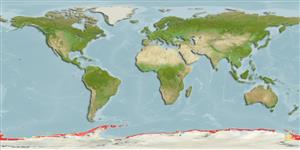Common names from other countries
Environment: milieu / climate zone / depth range / distribution range
Ecología
marino batidemersal; rango de profundidad 430 - 1120 m. Deep-water; 60°S - 78°S
Southern Ocean: east Antarctica (Davis Sea, Ross Sea, Weddell Sea), South Shetland Islands and South Orkney Islands.
Tamaño / Peso / Age
Maturity: Lm ? range ? - ? cm
Max length : 21.0 cm TL macho / no sexado; (Ref. 5181)
Feeds on isopods, gammaridean amphipods, octopods, polychaetes and mysids.
Life cycle and mating behavior
Madurez | Reproducción | Puesta | Huevos | Fecundidad | Larva
Eakin, R.R., 1990. Artedidraconidae. p. 332-356. In O. Gon and P.C. Heemstra (eds.) Fishes of the Southern Ocean. J.L.B. Smith Institute of Ichthyology, Grahamstown, South Africa. (Ref. 5181)
IUCN Red List Status (Ref. 130435)
CITES (Ref. 128078)
Not Evaluated
Threat to humans
Harmless
Human uses
Pesquerías: sin interés
Más información
ReferenciasAcuiculturaPerfil de acuiculturaRazasGenéticaElectrophoresesheritabilidadEnfermedadesProcesamientoMass conversion
ColaboradoresImágenesStamps, Coins Misc.SonidosCiguateraVelocidadTipo de nataciónSuperficie branquialOtolitosCerebrosVisión
Herramientas
Special reports
Download XML
Fuentes de Internet
Estimates based on models
Preferred temperature (Ref.
115969): -1.6 - 1, mean 0.3 (based on 415 cells).
Phylogenetic diversity index (Ref.
82804): PD
50 = 0.5000 [Uniqueness, from 0.5 = low to 2.0 = high].
Bayesian length-weight: a=0.00661 (0.00383 - 0.01141), b=3.16 (3.00 - 3.32), in cm Total Length, based on LWR estimates for this species & (Sub)family-body (Ref.
93245).
Nivel trófico (Ref.
69278): 3.3 ±0.46 se; based on food items.
Fishing Vulnerability (Ref.
59153): Low vulnerability (11 of 100).
Climate Vulnerability (Ref.
125649): Moderate to high vulnerability (50 of 100).
